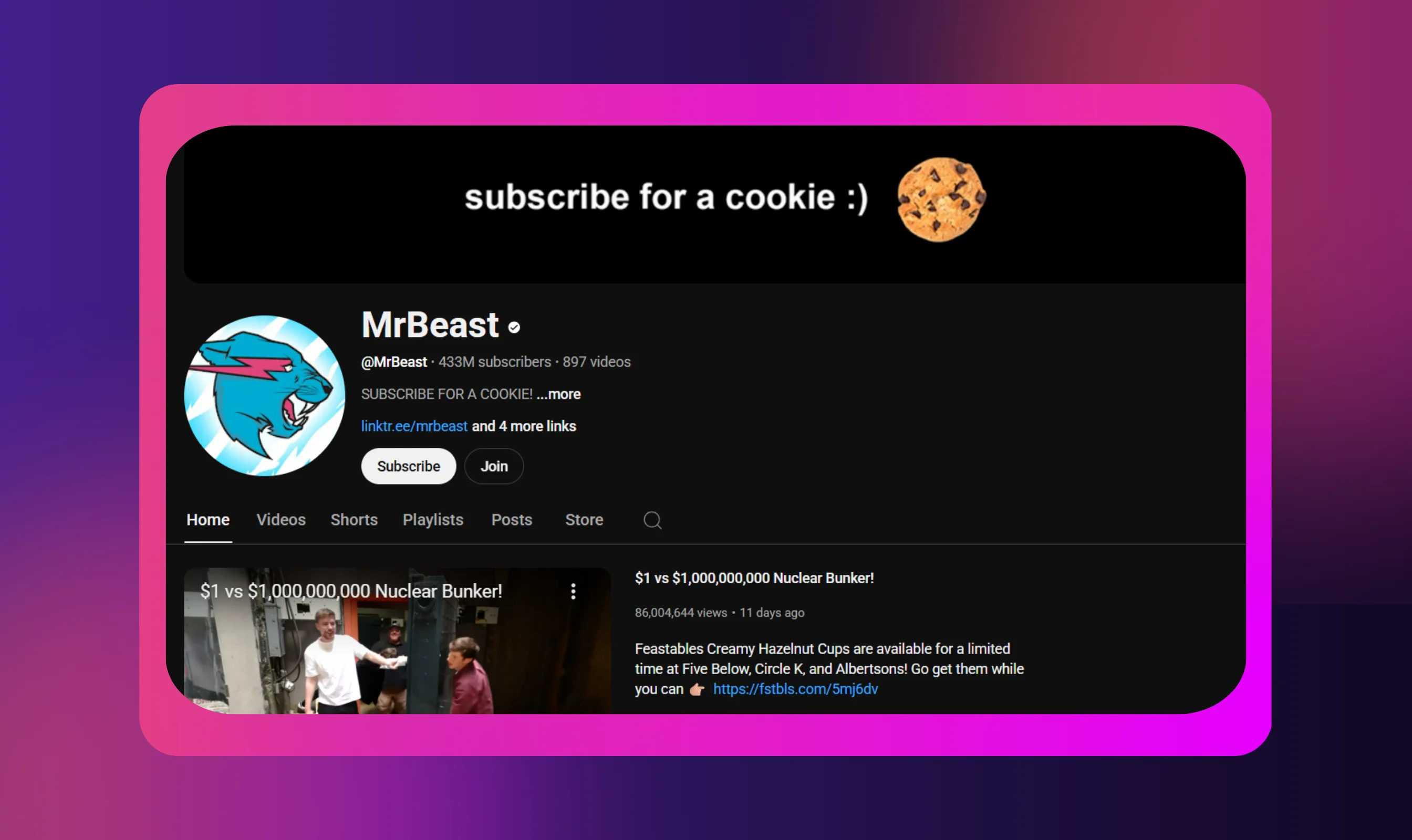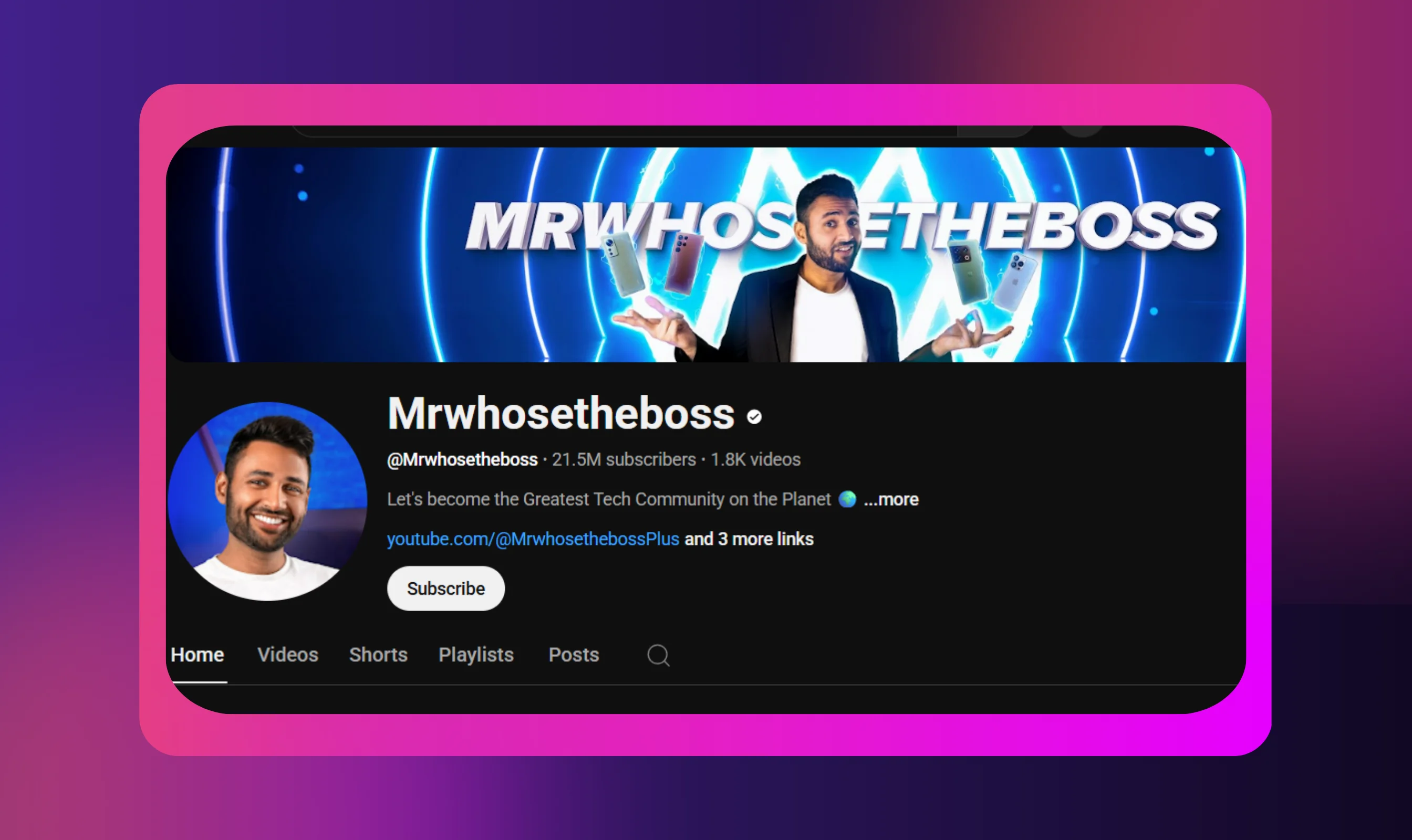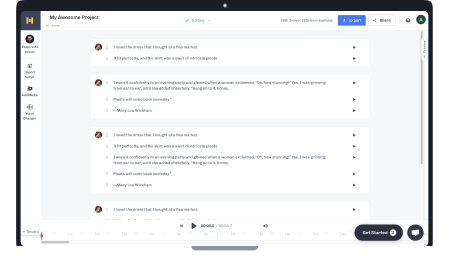How Much Do YouTubers Make in 2026? (Earnings by Size and Niche)
.webp)
For many aspiring creators, the biggest question isn’t how to start a YouTube channel; it’s whether it can actually pay the bills. With stories of viral success and millionaire creators making headlines, it’s easy to wonder what realistic earnings look like for most YouTubers today.
Take MrBeast, for example. Between June 2023 and June 2024, the platform’s most-subscribed channel earned $85 million from YouTube alone. While that number grabs attention, the reality is that only a small fraction of creators reach such heights.
So what do average creators really make in 2026? In this guide, we’ll break down YouTuber earnings by subscriber count, content niche, and income sources to give you a clear picture of the opportunities and limits of YouTube income.
Let's get started!
YouTube Earnings: An Overview
YouTubers don’t rely on a single income stream. The most common source is advertising revenue from Google AdSense by placing mid- and pre-roll ads.
But that’s only one part of the picture. Many creators earn through diverse means, including:
- Sponsorships
- Merchandise
- Memberships
- Affiliate marketing
- External platforms
However, one thing to keep in mind is that creator earnings can vary for a variety of reasons. Factors like channel size, niche, audience location, and engagement level all affect earnings.
For example, a finance channel often earns more per view than does an entertainment channel, even with the same number of subscribers.
Learn More: Best Video Editing Software for 2026
Understanding RPM vs CPM
When discussing YouTube income, CPM and RPM often get mixed up, but they’re not the same.
CPM (Cost Per Mille)
This is the rate advertisers pay for 1,000 ad impressions and is set by demand. Industries such as finance, software, and real estate attract higher CPMs because brands are willing to pay more for those audiences.
A gaming channel, on the other hand, might see lower CPMs because advertisers don’t bid as much.
CPM also changes during the year, as advertisers usually spend more around holidays, which pushes rates up.
RPM (Revenue Per Mille)
This refers to the actual amount a creator earns for every 1,000 views on their channel. Unlike CPM, which reflects what advertisers pay before platform deductions, RPM shows the creator’s net share. It accounts for YouTube’s 45% revenue cut, the impact of viewers using ad blockers, ads being skipped, and even whether ads were served at all.
RPM also includes other revenue streams such as channel memberships, Super Chat, or YouTube Premium subscriptions, giving creators a more accurate picture of their real earnings. Because of these factors, RPM is almost always lower than CPM but offers a truer reflection of what ends up in a creator’s pocket.
As a YouTuber creating videos, you need to understand that both metrics matter:
- CPM conveys the value of a channel’s audience to advertisers
- RPM reveals how much money YouTubers realistically make from their views
A channel could have a high CPM, but if ads are skipped or the audience isn’t fully monetized, the RPM may still be low.
Earnings by Channel Size
YouTube income grows with subscribers, not because of the subscriber count, but because of an increase in viewers. The earnings can vary depending on niche, location, and engagement.
Let's see how much ad revenue a YouTube channel can earn based on its subscriber count.
Beginners (1,000 Subscribers)
At 1,000 subscribers and around 4,000 watch hours, a channel is eligible to join the YouTube Partner Program.
According to Influencer Marketing Hub, the average RPM is typically in the range of $5–$6 per 1,000 views. A beginner channel might make $20–$50 a month if it gets steady traffic.
However, earnings still vary widely based on factors such as:
- The channel's niche
- The country where the views come from
- The engagement level of subscribers
This is why smaller creators can still earn well if they focus on profitable niches like finance, career advice, or technology.
Mid-Range Creators (10,000-100,000 Subscribers)
With consistent uploads, mid-sized channels can earn anywhere from a few hundred to a few thousand dollars per month.
As mentioned earlier, earnings depend heavily on the niche. For instance, finance or software creators may earn $5,000+ with relatively fewer views, while lifestyle or entertainment channels often make less.
At this stage, creators can also begin securing sponsored videos and brand deals, which often pay more than ad revenue alone.
For many, this is the point where YouTube shifts from being a hobby to becoming a reliable part-time income stream.
Established Channels (100,000+ Subscribers)
With over 100,000 subscribers, creators can earn their Silver Play Button and a high monthly income. Such creators often earn thousands per month from ads alone.
As they establish their channels, many successful YouTubers combine their ad revenue with brand deals, affiliate marketing, and merchandise sales to earn a considerably high income every month.
Sponsorships for a single video can range from $2,000 to $5,000, depending on engagement and niche. However, YouTube channels with high engagement make even more than $10,000 from a single sponsored video.
Million-Subscriber & Top YouTubers
When a channel surpasses a million subscribers, YouTube can become a full-time career. Here, a YouTube channel can become a real business empire.
Top creators often diversify into sponsorships, products, and even their own businesses. Below are three common ways million-subscriber channels expand earnings:
Channel Memberships
YouTube lets fans pay monthly fees to support creators directly. In exchange, members get perks like badges, emojis, or exclusive content.
For channels with one million subscribers, this ensures steady, expected income.
Merchandise Sales
Merchandise is a big part of revenue for top creators. They sell branded clothing, accessories, or digital products that allow fans to support them.
Many million-subscriber YouTubers partner with fulfillment companies to handle sales at scale, especially during festive seasons, such as Black Friday or Cyber Monday.
Sponsorships and Brand Deals
Brands often pay six figures for sponsored campaigns with top YouTubers. These deals usually bring in more than ad revenue.
This is especially the case when creators work in industries that value their audience highly, like tech, finance, real estate, or gaming.
How Much Does a YouTuber Make: Real-World Examples
Although looking at average earnings can give you an idea of how much YouTubers make, it never reveals the full potential of the platform.
Here, let's look at some of the highest-paid YouTubers from diverse niches:
Gaming and Entertainment
The gaming niche has significant potential to generate income through livestreams, sponsorships, and branded content.
Gaming channels attract viewers of the age group of 13-35. Making it a prime spot for brand deals and superchats. It also has a massive viewership and a strong sponsorship appeal.
Content often goes viral, which drives consistent ad revenue and leads to deals with brands and merchandise lines.
MrBeast

MrBeast, the highest-paid YouTuber, is a great example of how much a YouTube channel in the niche can earn. The channel has:
- Subscribers: 433 million subscribers
- Monthly income: $4.78 million
- Video focus: High-budget games, stunts, challenges, philanthropy
The channel has a strong revenue strategy with ad revenue, brand deals, merch media deals, and an Amazon Prime show.
Technology and Gadgets
Technology YouTube videos make a lot of money, as advertisers pay a high price for ad placement due to the audience these channels attract. This leads to higher RPMs and revenue.
This is also one of the reasons why there are numerous technology and gadget review channels. Many YouTubers make money not only from ads but also from partnerships and affiliate marketing with tech brands.
Mrwhosetheboss

Mrwhosetheboss is one of the biggest tech channels on YouTube. The owner of the channel, Arun Maini, has been uploading videos since 2011.
The channel has:
- Subscribers: 20+ million
- Monthly income: $39.2K
- Video focus: Tech reviews, product tests, explainer videos
The channel focuses on delivering highly creative videos and has a strong revenue strategy that combines ad revenue, sponsored content, affiliate marketing, etc.
Lifestyle, Comedy, and Vlogs
YouTube videos that focus on lifestyle, comedy, and vlogs help creators build their subscriber base really fast. While the RPM here may be lower than in other niches like tech or gaming, the potential to go viral is high.
Like Nastya
.webp)
Like Nastya is one of the most successful kid YouTubers in the world. The channel has been uploading videos since 2016 and has published over 980 videos.
The channel has:
- Subscribers: 130 million
- Monthly income: $332K to $1.99M
- Video focus: Children’s entertainment and educational content focused on songs, vlogs, and imaginative roleplay.
The channel is a favorite among children from diverse parts of the world.
Factors That Influence How Much Money YouTubers Make
Not all channels earn the same.
Two creators with equal views can take home very different amounts. That’s because income depends on several factors, like niche, geography, engagement, and how well creators use YouTube’s monetization tools.
Let's break down the primary factors that shape YouTube earnings, plus tips on how to optimize them.
Niche & Audience Geography
Some niches are more profitable than others.
- High-CPM niches: Finance, software, and tech often pay more because advertisers spend heavily.
- Lower-CPM niches: Gaming or lifestyle channels usually earn less per view.
You also need to consider where your audience lives. Views from the US, Canada, or Australia pay more than views from regions with lower ad spend.
Creators can boost earnings by targeting keywords and content toward higher-value audiences while still serving their core fans.
Engagement Rates & Watch Time
While views are good, there is something more important: watch time.
The longer people stay on a video, the more ads YouTube can serve them. Strong engagement through likes, comments, and shares also signals value to the algorithm.
All these help your videos reach wider audiences and increase ad revenue, and you can do this with a few tips, such as:
- Hooking viewers in the first 30 seconds
- Encouraging interaction through questions or polls
- Using pacing, visuals, or storytelling to keep interest high
High retention makes a channel more appealing for brand sponsors. Brands love to pay extra for creators with loyal, active audiences.
Diversified Income Streams
Of course, creating content and publishing it can bring you ad revenue. But it is never guaranteed. Hence, relying only on ad revenue is risky.
Successful YouTubers layer income sources to smooth out fluctuations.
Here are the common revenue streams that creators can focus on to diversify revenue for steady, expected income:
- Ad revenue (via AdSense)
- Sponsorships and brand deals
- Merchandise and product sales
- Channel memberships and Patreon
- Affiliate marketing
The more income streams a creator has, the more stable their business becomes. Even smaller channels can start diversifying early by adding affiliate links or simple merchandise.
Platform Changes & Monetization Tools
YouTube keeps adding new ways to earn. In 2023, Shorts monetization was rolled out, giving creators a cut of short-form ad revenue.
Other monetization tools also help, such as:
- Shopping features: They now let viewers buy products directly from videos.
- Fan-funding tools: Features like Super Thanks, Super Chat, and memberships help ensure steady income.
But with new tools, rules also change. For example, ad eligibility or music licensing updates can impact revenue.
The best way to ensure continued success is to stay updated with YouTube’s Creator Blog and use new features before others do.
Expand Your Income with Global Reach
.webp)
One of the fastest ways to grow YouTube income is by reaching audiences beyond your home country.
Dubbing videos into multiple languages helps creators tap into entirely new markets. It helps increase views and watch time, as viewers get to enjoy content in their native language.
Global reach also attracts international sponsors willing to pay more for access to localized audiences.
While there are diverse tools to help you with content localization, Murf AI Dubbing stands first in line with its AI-powered functionality.
With Murf’s AI audio dubbing tool, you can translate and ensure high-quality video localization at scale, making content accessible worldwide.

Frequently Asked Questions
How much does YouTube pay per 1,000 views?
.svg)
How much YouTube pays per 1,000 views depends on a range of factors, such as the niche, audience engagement, and watch time. However, the estimated daily earnings of a channel on average per 1,000 views can fall between $5 and $6.
What can a YouTuber with 100,000 subscribers expect to earn?
.svg)
With 100K subscribers, a channel has many options to earn money other than the YouTube ad revenue. Options like affiliate marketing, selling digital products, brand sponsorships, and capitalizing on your visibility on different social media platforms can also bring in revenue.
But on average, such a channel can make $1,000 to $5,000 per month from ad revenue, depending on niche, audience location, and engagement.
Who is the highest-paid YouTuber?
.svg)
MrBeast was the highest-paid YouTuber in 2024, earning over $85 million from his YouTube videos and related ventures.
How many views do you need to make $1000 a month on YouTube?
.svg)
It depends on factors like niche, audience demographics, and video length.
Roughly speaking, if your channel averages an RPM of $5, you’d need about 200,000 monetized views per month to make $1,000 from ads alone. However, even smaller creators can reach $1,000 a month by combining ads with channel memberships, sponsorships, or affiliate marketing.
What is the average full-time YouTube income?
.svg)
The actual earnings of a full-time YouTuber can vary based on the number of subscribers, niche, audience engagement, frequency of video uploads, and more. For example, a YouTube account with longer videos on finance with 5K subscribers can earn more money than a lifestyle channel with the same number of subscribers.















